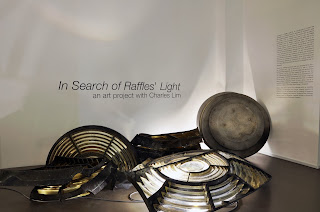Diary of an NUS Museum Intern: Tan Teen Zhen
Note: Diary of an NUS Museum Intern is a series of blog posts written by our interns about their experiences during the course of their internships. Working alongside their mentors, our interns have waded through tons of historical research, assisted in curatorial work, pitched in during exhibition installations and organised outreach events! If you would like to become our next intern, visit our internship page for more information!
-
Tan
Teen Zhen is a third-year
Chinese Studies student from Nanyang Technological University. As the Resource Library and Curatorial Intern,
Teen Zhen researched and devised strategies for the
display and organisation of the Museum’s
library collection.
As the Resource
Library and Curatorial Intern, I was paired up with another intern, Xu Xi, to work
on curatorial strategies and assist in organising materials in the NUS Museum
Resource Library.
My first
week with NUS Museum started not with the museum library itself, but with
visits to libraries around Singapore. Xuxi and I sought inspiration from other
libraries and to see what is it that we could do differently. Some of the things
we took note of included the classification system used in the libraries, the type
of material that was sorted and the way shelves were arranged.
The
Resource Library is made up of gifts and donations to the museum, purchases
made over the years by curators as well as books inherited from the Nantah
Collection. These materials include books, exhibition catalogues and
encyclopaedias amongst others. Cataloguing and organising the materials had
been a great learning experience as I explored a myriad of topics in art
history, Chinese art and archaeology that I had never known about.
Some of the books/subjects I read about
We were also
tasked by Kenneth, our supervising curator, to research and find out more about
classification systems in libraries. How else can books be sorted if not by
categories or by the Dewy Decimal System? Through this process, I began to
develop an awareness and sensitivity to the use of different classification systems
in libraries. Here I quote from one of our readings, intercalations 1: Fantasies of the Library, “Library classification
systems are rational structures inherently motivated by a “fear of being engulfed
by this mass of word s,” and yet, even if they are powerful enough to suppress
this fear, in so doing they proliferate other limits, cracks, and misguided
trajectories.” (pg 25). Perhaps there will be no truly objective library
classification system, for the narratives that form as a result of books
interacting with one another on the shelves carries with it a certain bias,
shaped by the system itself. Understanding how libraries, depositories of human
knowledge, are shaped and structured will allow us to be more conscious of the
ways we think and learn.
Kenneth encouraged
us to think about classification systems for the Chinese collection which could
facilitate new connections between different subject matter as well as provoke
thought about library systems. Hence, instead of simply arranging materials by
subject matter and using established classification systems, Xuxi and I sought
other methods of arranging which would reflect the content and type of library
materials. We also wanted to explore possibilities of surfacing existing
debates in Chinese scholarship through our work. The content of library
materials and the fact that they were library
materials, however, both limit and liberate the possible connections we can
make. We experimented with alternative ways of classification and eventually
decided to arrange the collection by— visit to find out!
Usual work at the Library
Aside from
working in the library, many other activities kept me busy during the
internship. One of which was the Internship Dialogues. It was an opportunity for
us to pursue our research interests with a presentation as an end product. Looking
back now, trying to accommodate research interests of everyone in the group was
what prompted me to step out of my comfort zone and tackle my topic on Chinese
art history from a different direction and perspective. I also learnt a lot
from the presentations by other interns and subsequent discussions that
followed.
With Diyanah after the Dialogues
Another
aspect of the internship which I enjoyed were the curator tours around museums
in Singapore. Starting with the Museum and Baba House, Siang, Su Ling and
Kenneth brought us interns on curator tours around exhibits such as the Vietnam
War exhibits (“Who Wants to Remember a War?” and Lines), Archaeology Library
and Ng Eng Teng: 1+1=1, just to name a few. We were also privileged to hear Kenneth
talk more about the ideas behind the upcoming exhibit in NX1, consider it a
sneak peek if you will! I also enjoyed the tour by Ailing at the Substation
very much. This is partly because I had never been to the Substation, and
partly because I appreciated knowing more about the position of smaller local
arts institution or spaces in Singapore and their struggles to keep true to
what they want to achieve for local arts.
I want to
thank NUS Museum for providing me opportunities to listen in on worthwhile
experiences of curators, filmmakers and conservators. I would also wish to
thank Kenneth for always asking thought-provoking questions and giving me
opportunities to initiate and learn. Special thanks to Michelle, Trina, Johnathan,
Philip and Donald for guiding and accommodating me for the past 11 weeks. Last
but not least, I would like to thank my fellow interns: Xuxi, Chutong, Diyanah,
Mary Ann, Nicole, Joshua and Zhien for the lovely conversations, discussions
and company throughout this internship.


Comments
Post a Comment